DIY chandelier connection
A seemingly simple operation - installing a new chandelier - can confuse a person unfamiliar with an electrician: a bunch of wires and it is not clear what and with what to connect. We will discuss how to connect a chandelier with a different number of horns (and wires) to the switch.
The content of the article
Preparation: continuity and phase detection on the ceiling
Those who do not need this even a little with an icon with power grids, the rest will be useful. It can be difficult for a person who does not constantly deal with electricity. In order not to get confused, we will tell you everything in order: how to find the phase (or phases) and zero in the wires on the ceiling, what to do with grounding. And then, like a whole bunch of wires on the chandelier, connect with those that stick out above. As a result, connecting the chandelier with your own hands will be an easy task for you.
Ground wire
If the wiring is already done, two, three or four wires stick out from the ceiling. One of them is exactly "zero", the rest is a phase, there may still be grounding.
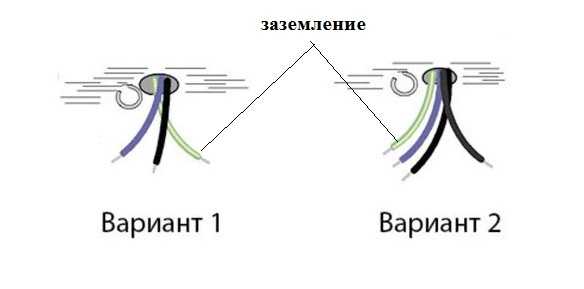
Ground wire is available in newly built or recently renovated houses
There is not always a ground wire, only in newly built houses or after major repairs with the replacement of electrical wiring. According to the standard, it has a yellow-green color and is connected to the same wire on the chandelier. If your chandelier does not have it, we carefully insulate the bare wire and leave it as it is. You cannot leave it uninsulated - you can accidentally short-circuit it.
Looking for phases and zero
The rest of the wires need to be dealt with: where is the "phase" and where is "zero". In old houses, all wires are usually the same color. Most often black. New buildings can be black and blue, or brown and blue. Sometimes red is present. In order not to guess by the colors, it is easier to ring them.
If you have three wires on the ceiling and a two-button switch on the wall, you should have two "phases" - for each of the keys and one "zero" - a common wire. You can call it with a multimeter (tester) or an indicator screwdriver (this is a special screwdriver with a light that lights up when there is voltage). During operation, turn the switch key to the "on" position (input circuit breaker on dashboard also included). After dialing, turn the switch keys to the "off" position. If possible, it is better to cut down the machine on the dashboard and connect the chandelier with the power off.
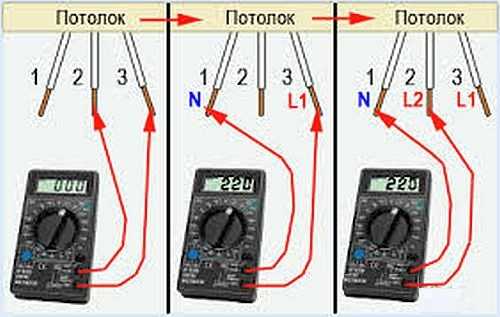
Continuous ringing of wires on the ceiling with a Temter
How to ring and identify the wires with a tester is shown in the photo. Set the switch to the "volts" position, select the scale (more than 220 V). Alternately touch the pairs of wires with the probes (hold the probes by the handles, do not touch the bare conductors). The two phases do not "ring" with each other - there will be no changes on the indicator. If you find such a pair, most likely it is two phases. The third wire is most likely "zero". Now connect each of the proposed phases with probes to zero. The indicator should be 220 V. You found zero - in the international specification it is denoted by the letter N - and two phases are denoted by L. If all wires are of the same color, somehow mark them: paint, a colored marker, a piece of adhesive tape. Phases - in one color, zero - in another.
Working with an indicator screwdriver is easier: just touch the end of it to the bare conductor. Lit - phase, no - zero. Very simple.
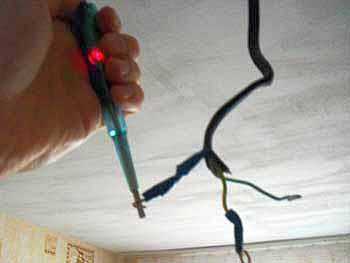
Using an indicator screwdriver to find the phase
If only two wires stick out, then one of them is a phase, the other is zero. In this case, there is one key on the switch. There are no other options.
Read about the rules and methods of connecting wires in a junction box here.
Chandelier wires
It is easy to connect a chandelier with 2 wires: screw one of them to phase, the other to zero. Whichever - it doesn't matter. If there are two phases on the ceiling, and the switch on the wall is two-key, there are options:
- Twist the phases together, and connect one of the wires from the chandelier to them. In this case, to turn it off, you will have to move both keys to the “off” position, and the lighting will turn on from either of them.
- Connect the wire to one of the phases, insulate the other. Then only one key will work. The second is to be empty.
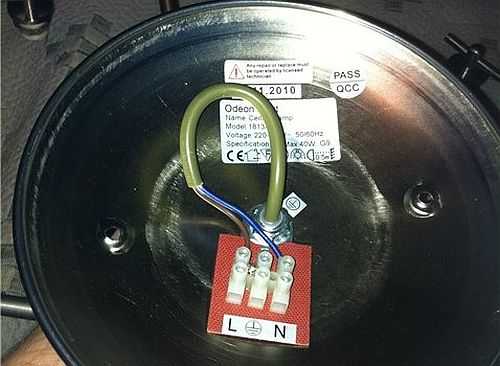
How to connect a chandelier if it only has two wires? To the same wires on the ceiling in no particular order
On multi-track chandeliers, there are definitely more than two wires. We have decided on the purpose of the yellow-green. This is grounding. If the same wire is on the ceiling, connect to it. The rest also need to be dealt with.
The 3-wire chandelier is not much harder to connect. If one of them is ground (yellow-green) it can be:
- ignore - if wires of this color (or similar) are not on the ceiling,
- connect to the same color.
Actually, there are no other options. Three wires are mainly found in luminaires with one bulb. With two it is an outdated design, with three it is a more modern one, corresponding to the current recommendations.
Connection to double switch
Connect a five-, four-, three-arm chandelier to a two-key switch according to the same principle. Each of the horns has two colored wires. Most often these are blue and brown wires, but there are other variations. To connect to a double switch, all of them must be divided into three groups: two phases and one zero.
First, all the blue wires are connected together and twisted well. This is zero. In principle, you can take wires of a different color - this does not matter for lighting fixtures. But according to the standard, blue means exactly "zero". It is only important that conductors painted in a different color do not get into the twist. In the photo below you can see that all the blue conductors are combined into one group. This is zero.
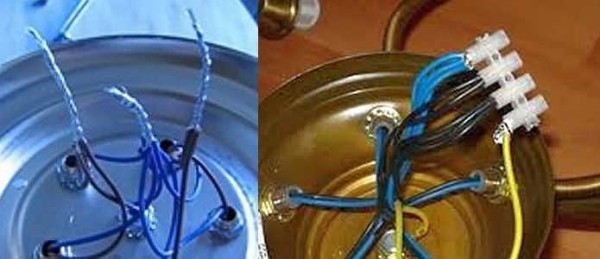
Before connecting the chandelier, the conductors group
Now divide the rest into two groups. The breakdown is arbitrary. One group of bulbs will turn on from one key, the second from another. In a five-arm chandelier, usually 2 + 3 are combined, but 1 + 4 is also possible. There are also two options in the four-arm - 2 + 2 or 1 + 3. But with three bulbs without options: 1 + 2. Twist the separated wires together. Received two groups that connect to the "phases" on the ceiling.
How to connect a chandelier to a single switch
If there are only two wires on the ceiling, and there are many wires on the chandelier, but only two colors, everything is simple. Twist all conductors of the same color with bare parts and connect to one of the wires on the ceiling (no matter which one). Collect all the conductors of the second color into one bundle and connect them to the second ceiling. The chandelier connection diagram in this case is shown in the figure below.
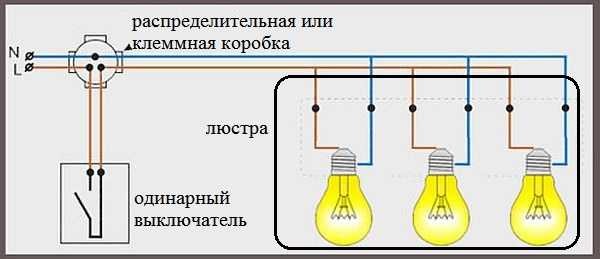
Diagram of connecting a chandelier to a one-button switch
With this inclusion, all the lamps will light up simultaneously.
Wire connection rules
When working with electricity, there are no trifles. Therefore, we connect the wires in the chandelier in accordance with all the rules. When combined into one group, it is not enough just to twist them and screw on the protective cap.
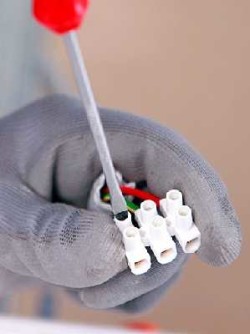
You need to connect the wires from the chandelier and the switch in the terminal box
Such a twist will sooner or later oxidize and begin to heat up. It is highly desirable to solder such connections. If you know how to handle a soldering iron and tin, be sure to do it. This will guarantee normal contact and the connection will not heat up.
Now about how to connect the wires from the chandelier to the wires from the switch (which are on the ceiling). According to the latest rules, twists are not allowed. Terminal boxes must be used. Most modern chandeliers are supplied with them. If not, buy at any hardware store or lighting dealer.
When using such a terminal box, a problem arises: twisting of a large number of wires simply does not fit into the hole. Output: solder a conductor to the connection (copper, single-core or stranded, with a cross section of at least 0.5 mm2). Insulate this connection well, and insert the free end of the soldered conductor into the terminal box (a long one is not needed - cm 10 is more than enough).
By inserting all the wires from the chandelier into the terminal block and tightening the screws, the entire structure is raised to the ceiling. There it is pre-fixed, after which the wires are connected to the terminal block in the right order. In this case, it is important to set "zeros" one opposite the other. Phases to phases are connected in random order.
The correct connection of wires in the junction box is described here.
How the wires are divided on the chandelier, how the conductor and the chandelier are connected to the terminal block - all this is in the video.
Connecting a Chinese chandelier
Most of the relatively inexpensive chandeliers on the market come from China. What they are good at is a large assortment, but there are problems with the quality of the electrical assembly. Therefore, before connecting the chandelier, you need to check its electrical characteristics.
First, the integrity of the insulation is checked. They can be assembled into one bundle and short-circuited to the body. The tester should not show anything. If there are any indications, you have two options: look for and replace the damaged wire, or take it to exchange.
The second stage of testing is checking each horn. Two wires go from the horn. They are soldered in the chuck to two contacts. Call each wire with the corresponding contact. The device should show a short circuit (short circuit or infinity, depending on the model).
After checking, start grouping the wires as described above.
Connecting a halogen chandelier (with and without remote control)
Halogen lamps do not work from 220 V, but from 12 V or 24 V. Therefore, step-down transformers are installed in each of them and the whole circuit is assembled and ready for installation. Only two conductors remain free, which must be connected to the wires protruding from the ceiling. It is connected in any order, "phase" and "zero" do not matter.
If the chandelier is equipped with a remote control, a control unit is added to the transformers. The connection is the same: there are two conductors that need to be connected to the ones on the ceiling. The third conductor coming from the other side (it is thin) is the antenna through which the remote control and the control unit communicate. This conductor remains inside the glass as it is.
How to connect a chandelier with a remote control, see the following video.

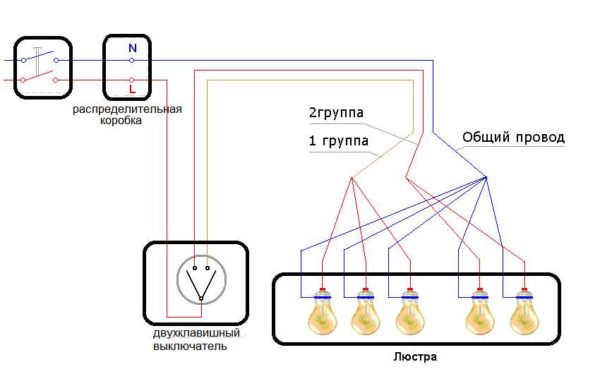
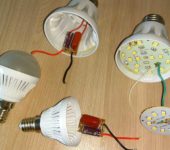

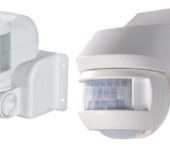

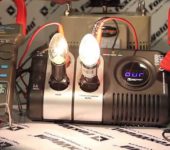





Just a gorgeous article, put everything on the shelves. Thank you so much!)
Thanks to the author for the article. Chewed 5 points.
I was looking for such a detailed article, but only again twisting and screws, weakening over time. The sleeve is a good option, but how to connect 5 neutral wires with it? Twist it again and stuff it into the sleeve? Wago addresses the issue of the miniature tee. Those. it is akin to an extension cord for 6 sockets, into which we plug a table lamp, a heater, a TV, a music center, and a mobile phone recharging, for example, well, or "6 bulbs". But there is so much conflicting information about Wago on the Internet and the lack of unambiguous and detailed information on the official website that they seem to be holding back something on purpose. That I again chose NShVI + sleeves, but I do not see sleeves with 6 branches.
I would add advice that it is preferable to connect the neutral wire to the threaded part of the socket, since sometimes the bulb of the bulb falls off the base and you have to turn out the rest of it with pliers or hands. And if you forget to turn off the switch, and if the phase is on the threaded part, then you can get under voltage
You're right. Thanks for the clarification.
Hello! I have several questions regarding chandeliers made in China, for a start, two of them:
1 - is it possible to replace halogen lamps with LED ones?
2 - is it possible to replace 12 V lamps with 220 V excluding transformers from the circuit, of course?
The rest of the questions regarding the connection itself, after your answer.
The lamps can be replaced, but the lamps must be 12V. Replacement to 220V is not possible, as all components are designed for low voltage.
Thank you. What components are we talking about? Wiring inside the chandelier?
Thank you, I was not an electrician, but I installed a chandelier)
Excellent ... you are great
Tell me, I moved to a new building, 4 wires stick out there.
The switch is two-key, therefore there are 2 phases, one zero and ground.
The question is that we have a very old chandelier (antiques), six-arm, and 3 blue wires sticking out of it, I'm at a dead end.
You, most likely, also have 2 phases on the chandelier. Take the tester and ring the wires that go from the chandelier in pairs (the tester is in the dial position, when the probes touch the wires, the arrow should deviate, then they say that the wires "ring"). It should be like this: with one of the wires, both others will ring. This wire will be "neutral" or "zero". The other two are phases. These two phase wires should not ring among themselves. To distinguish these wires, label them somehow. For example, glue a piece of duct tape to neutral or draw stripes with a marker / nail polish. When you connect the chandelier to the switch, connect the neutral to the neutral, the phase wires to the phase wires.
L L1 © N - ceiling lamp
Blue, Brown, Green - from the ceiling.
Two-button switch. How to connect.
They explained everything perfectly. Thank you. It is very interesting to remember and refine knowledge of physics. I'll wait for my son and set it up with him.
Hello) assembled the 6 horn chandelier herself) according to your recommendation, but came to a dead end (I connected the wires from the horns as it should be in blue and distributed the brown ones by three), but now it is NECESSARY to connect it all into one BIG wire from which ONLY two thin blue wires come out and brown I need all the blue to blue brown to brown and then just extend it into the circuit and bring it to the ceiling wires, where and connect it to the junction box) but then all the lights at the double switch will be on? Please help me how to do it CORRECTLY
If you have a two-button switch, there should be three or four conductors on the ceiling - two phases and zero (the fourth is ground). There should be three bundles on the chandelier: one common from blue wires, two from brown ones. Connect the blue beam to the neutral, the brown ones in phases (it doesn't matter which where). If there is a grounding - it is separate to the green wire. For clarity, added a video. Look, it might be clearer. Only after checking the phases on the ceiling, before connecting the chandelier, turn off the power (it is better to use an automatic machine on the shield or unscrew the plugs if the wiring is old).
What's behind your BIG wire? Where is he from?
Hello, only 2 wires stick out of 5 horn chandeliers.And on the ceiling 4 there is a double switch, how to connect it all?
In this case, it will be possible to connect to only one of the keys. Phase wires can be connected on the ceiling (check with a tester). Connect one of the chandelier wires (no matter which one) to them. Find a neutral on the ceiling and connect the second wire from the chandelier to it. Insulate the rest (ground). With this option, you will have to turn off and turn on two keys once. If this is inconvenient, use one of the phase wires, and insulate the other (very carefully with it, with the machine turned off on the dashboard).
Hello. Tell me, what wire can and should be used to connect spotlights? I mean the part of the wiring that goes after the junction box directly to the lamps in the ceiling?
The connection will be a loopback.
I recommend using a three-core copper cable NYM-J 3 × 1.5 - you can buy in Leroy Merlin at a price of about 32 rubles per meter. The letter J in the marking indicates the presence of a yellow-green core in the cable.
About the connection with a loop. Here you need to decide whether you will make connections according to GOST or not.
GOST 50571-5-52-2011 paragraph 526.5 “Conductor connections (not only end connections, but also intermediate connections) must be made in housings, e.g. in junction boxes, control cabinets, or in equipment if the manufacturer has provided space for this purpose. The equipment shall provide devices for connecting conductors or a place for installing a connection device. Conductor lugs must be placed in a sheath ".
The fact is that often, when connecting luminaires with a loop, WAGO terminal blocks are used. In this situation, each spotlight will require three terminal blocks, while the connections will not be in the junction boxes.
It seems to me, ideally, for each lamp there should be a separate wire from the junction box. If the luminaires are installed in a bathroom (damp room), then the junction box must be placed outside this room.
Good evening! Please tell me, I have three white wires coming out of a 3-arm chandelier. There are 3 wires on the ceiling, 2 phases 1 zero. A 2-key switch only 2 wires go from the switch box to it. Phase and zero. Is it possible somehow without testers
using the selection method, connect a chandelier for 2 + 1. Thanks in advance
Hello! It is possible without a tester. Connect in no particular order. Apparently, your chandelier is assembled for 2 + 1. So what and where to connect - no difference. But, if the chandelier is expensive, it would be better to check what the manufacturers have done there ...
Hello. Such a problem, there are two wires from the chandelier, and three wires in the switch box. One phase, two zeros. I connect the vase and zero to the switch, the indicator shows two phases, I change the wires, sometimes all three phases show
Hello, tell me a chandelier for 5 horns from each horn 2 wires come out - phase and zero, copper stranded wires. To collect all phases and zeros without twisting and insert into the wago terminal block for 5 positions. Is it possible to 5 phase wires in one terminal block and 5poles in another insert the terminal block? and such a question is still the main contacts that go in the cable along the chandelier phase and zero how to connect to these terminal blocks? can one phase be thrown into the terminal block with phases and zero to the terminal block with zeros. it turns out that there can be two contacts in one terminal? thanks for the answer!
Hello! The wires from the horns can be connected as you said. But there should be two terminal blocks. One is for phase wires (5 from the horns + phase from the switch), the second is for neutral wires (also 5 wires from the horns and one from the ceiling). Phase and zero cannot be pushed into one terminal block.
Did I understand correctly for clarification - it turns out that in the terminal block for 5 wago contacts I draw 5 phase contacts from the horns and there I can make a phase contact in one of the terminals to the contact, so it turns out that 2 contacts will be clamped in one position? This is allowed, that 2 contacts will be clamped in one position? thanks for the answer!
Do you mean that there will be two wires in one cell? This is possible, although not recommended. It is better to find a terminal block with a large number of sockets (if you decide to take Vago, they have 8 contacts). But there must be necessarily two separate terminal blocks - for phase conductors and neutral. The drawing is schematic, sorry for the quality.
Yes, I mean that there will be two wires in one cell. Yes, it is clear that there should be two separate terminal blocks, one for the phases and the other for neutral. Thank you for the answers)!
I want to ask a question? If two yellow-green wires and two blue wires are brought out of the ceiling, the light is connected to two blue ones and the disconnection of one of the buttons of the double switch lights up. When disassembling the switch, a standard connection was found, from one phase to two, and the outlet is on the ceiling, one phase on the blue wire.
I cannot understand anything, tk. the first time I encountered this.
Maybe you know something, tell me ??? ..
You described something incomprehensible ... Or maybe they brought out a couple of wires from somewhere else, but didn't put the switch?
Hello. I have such a situation: I connected the chandelier as expected into 2 phase groups and one zero. But on the ceiling I ran into that. that there are two zeros and one phase. How to make the connection to the two rocker switch?
hello such a question, I took off the chandelier to wash it and then the problem appeared! on the chandelier itself there are 3 wires, although they are of the same color, but one wire goes separately, that is (zero)! but with the ceiling, the problem is the old wiring three wires of white color (still Soviet wiring) and so I checked it with an indicator screwdriver and it shows that one wire is phase and two are zero (the light on the screwdriver is not on)! can this really be? because if you mix up the wires, you get short
If I understand correctly, then a chandelier for a two-button switch. If everything is done correctly, then with the switch on, there should be zero on one wire, on two phases. In your case, the switch breaks zero, and the phase goes directly to the chandelier. Actually, there is nothing unusual in this situation. As for the short circuit, I can't figure out where it can come from, even if the wires are mixed up.
And try to measure it with a tester ... maybe one of the "non-burning" is grounding?
I want to ask a question: in the Eurosvet 90081/8 LED chandelier, the wires from 3 transformers are connected to some
a box in a heat shrink, from which brown, blue and black wires come out. When the network is connected to the first two wires, the entire chandelier glows. What is the black wire for and where to connect it?
Maybe black - ground? If you don't have grounding, just bend it and insulate it so that the bare wire does not stick out.
Prompt, there are two wires on the ceiling, a switch with one key. There are three wires on the chandelier: white, blue, black. Tell me the connection diagram.
Need to understand that the chandelier is not LED? Apparently, one wire is neutral, two are phase. European manufacturers have a blue neutral wire. Well, it's better to ring. Since the switch is single-key, the neutral wire of the chandelier is connected to zero, and the other two are twisted together and connected to the phase going through the switch.
Good evening! Please tell me how to connect the Xiaomi Mi Yeelight Smart LED Lamp, if there are three wires on the ceiling "phase, zero and ground, and the lamp has only two inputs for wires L and N. What to do with grounding?
Just insulate the ground.
Please tell me how to connect a 6 arm chandelier to the 2nd switch if there are only 2 wires on the ceiling, phase and zero ???
It is necessary to see if there is an opportunity to "find" the missing wire. If not, then instead of a switch put a dimmer - you can smoothly adjust the lighting. If the chandelier has LED lamps, then when buying a dimmer, it is better to clarify whether it is suitable for LED lamps or not.
From the ceiling there are 2 wires, a chandelier with 3 wires. How to connect? Thank you.
Hello. Today I decided to change the chandelier, there are two wires in the ceiling, 3 in the chandelier (with grounding), I don't have a screwdriver, so I tried to connect by typing (later I found your site and tried your method). Only now, I ran into a problem, no matter what wires I connected to the new chandelier, it still did not light up. I decided to put the old one, for sure (I thought), but it did not turn on either. So I don't even know what to do. The wires in the ceiling are white, in the chandelier they are also monochrome. Double switch, connected to the lights in the yard, one switch should turn on the lights in the yard, the second in the kitchen, the chandelier for me. in the kitchen.
An indicator screwdriver, at least the cheapest, is always best at hand. First, you need to find the phase, the rest along the way.
Hello! The three-arm chandelier has been disassembled. For each horn there are two wires, blue and brown, and for two horns the wires were twisted (blue and brown), and for the third horn, the wires were, as it were, for stripping, the shell was cut and slightly moved forward. but you need to connect them to two wires, respectively to blue and brown, they also have wires for stripping, the shell is cut and shifted slightly forward. So I sit and suffer. Why do two horns have output wires between themselves in a twist, and on the third horn of the wire under cleanup !!! ??? Well, the second torment, how to put it all together ??? Thanks in advance for the answers.
To be honest, I didn't understand everything, but oh well. If we are talking about an ordinary chandelier designed for 220 V bulbs, then you need to connect the wires from all three horns in parallel - twist three blue wires and three brown wires together. Then you can connect the wires from the one-button switch.
I will add that the switch is single-phase. Immediately on three lamps. It's too bad that the photo does not line all my wires. (((
Thank you. I figured it out already)
Good afternoon, tell me please, a three-arm chandelier and there are two black and white wires for each horn (which phase and zero?) Plus separately yellow, there are also two brown and blue wires in the ceiling ... how to connect?
Yellow is clearly grounding, you have nowhere to connect it. Connect the three black wires and the three white wires together. In random order, connect the supply wires from the ceiling to the two resulting twists. After checking the operation of the chandelier, unscrew one light bulb and check with an indicator screwdriver that the phase is on the central tongue of the cartridge. If this is not the case, swap the supply wires. This is done for safety reasons - if the skirt of the cartridge is energized, it is more likely to touch it with your hand, for example, when replacing a lamp with a broken bulb.
Good day. Explain to a stupid, in terms of electrician, person the situation.Two-button switch, three wires from the ceiling, blue - the screwdriver lamp is off, yellow-green and gray - the lamp is on. Does it mean blue zero, and yellow-green and gray phase?
Yellow-green should be zero, but they could have been confused during installation. Personally, I would take a 220V light bulb and carefully connect it first between blue and gray, and then between blue and yellow-green. So you can find out everything for sure. The fact is that the indicator screwdriver can react to interference.
And what will happen if the zheto-green, as in a fairy tale, turns out to be zero?
Hello!
Tell me if there are 4 wires from the ceiling, there is no yellow-green among them. How to understand which is zero and which is grounding?
If there is a circuit breaker, take any load. A light bulb, for example. You probably found the phase wires. We bring a phase to one contact of the lamp, an unknown wire to the other. If it is "zero", the lamp will simply light up. If "ground" - the circuit breaker will work.
The second way to determine where is zero, and where is the phase - when the power is completely turned off, ring the wires to the ground terminal (the riser of the water supply, the body of the shield, but touch the cleaned area of metal without paint and rust). The wire that "rings" (shows a short one) will be earthed. a wire with almost no readings is neutral (zero).
Good time to the author, admin and visitors!
A big request for help to deal with a not quite standard solution.
Apartment in the house of the PD-4 series. The house was built in the late 90s.
In stock:
1. One amateur with experience in primitive connections.
2. One old and faithful control screwdriver with a light bulb in the handle.
3. One switch (why not a switch?) Legrand Valena two-key.
4. A socket for a switch with 5 wires - one blue, one white, three .. cheerful .. brown, one of which is insulated by an unknown electrician with a different black electrical tape.
5. A socket for a chandelier on the ceiling with three brown wires (no others), two of which are connected to a socket with a light bulb, and one is insulated.
6. Chandelier from IKEA for 5 arms with paired 2x3 connectors zero / phase / ground.
7. Broken template.
Can you please tell me how to combine all this into a working configuration?
Thanks in advance!
Good day,
Need help installing a chandelier on a double switch.
There are three wires in the ceiling: blue, brown, green.
Chandelier 7 horns, I want to turn on 4 + 3.
The gag is as follows:
on the twists of the horns - it is clear, the blue ones are all together, the brown ones I twist 4 + 3. It turns out three twists.
But then I need to connect these twists to the wire in the chandelier, which goes in the tube to the ceiling, and in the wire there are three cores, one of which is the ground and this core is already screwed onto the chandelier body, two wires remain - blue and brown.
Question: how to connect my three twists to these two wires for a 2-key chandelier to work?
Thank you in advance for your response.)
Let's think logically 🙂 From the ceiling comes zero and two phase wires connected to the switch. Accordingly, they should be connected to zero on the chandelier and loads of three and four lamps. A common wire coming out of the chandelier is required. Unscrew the ground wire from the chandelier and turn it to zero, i.e. screw to a twist with blue wires. The fact is that it will still not be possible to ground the chandelier, since for this a four-core cable must come out of the ceiling.
Hello. the question is: we have an exit on the ceiling, three wires 2 black and one blue (old samopal). we have an antediluvian three-arm chandelier (the wiring is hidden in the chandelier box), from the central pin of which three white wires (2 thin and 1 thick) come out.How to stick this mess on the ceiling? I'll find a phase indicator on the ceiling, so what? Double switch.
If the chandelier is three-arm, then logically, all the bulbs light up simultaneously, i.e. the chandelier is designed to be connected via a one-button switch. If this is the case, then one of the wires coming out of the chandelier is a ground screw screwed to the body (if the body is metal). We need to find a ground wire, maybe this is a thick wire, but maybe not. The other two wires are connected to the load. It is desirable that the phase comes through the switch to the central spring-loaded contact of the cartridge.
Next, you need to look at what wires come out of the ceiling. It is possible that this is ground, zero and a phase going through the switch.
Uv, Vladimir, I think it's not so. Since at the moment a dead one is hanging out, since the time of the dinosaurs, a 6-arm chandelier, a switch for 2 keys. In a three-arm chandelier (which is doomed to climb the scaffold and be hanged), 3 insulated twists are hidden in its box, where thick white wire is mixed into one of the twists. It is not screwed anywhere to the body of the metal chandelier, it is stupidly mixed into the twist and brought to the connection point. These are the pies we have with you.
Maybe it makes sense to take a cord with a plug and just apply voltage to the chandelier right on the floor? It seems that the chandelier, though three-arm, but under a double switch. If so, then one light may be on, two or all three. It is possible that the thick wire is common.
ok, tomorrow I will try to do so. I will look at the result and, with your permission, I will report back.
Hello. The spouse was bewildered)) It is necessary that the entire chandelier (group 1) should be lit from one key of two key switches, and from the second key only part of the bulbs from group 1. Is it possible and how?))
If all the lamps light up from one key, then they all must be turned on in parallel. Conclusion: the trick will not work. Why was such an opportunity needed at all?
Hello. Chinese chandelier, output 1 wire white, 2 wires in a paired wire separately. Which wire to use with a phrase. The switch is double, but you can also single, if only it works
Logically, the white wire is zero, the two remaining wires are for connecting to a double switch, i.e. they are supplied with 220 V through a switch.
Hello, I ask for help from those who are knowledgeable and those with experience.
I connected a chandelier (an ordinary three-arm, for 2 contacts, but it seems to be made soundly, not in Chinese). I twisted 3 blue wires into a twist, and 3 brown wires into another, through the terminal box. Everything is neat, the "hair" does not stick out, it is insulated.
I remove the old working "Ilyich's light bulb", connect a new chandelier (the wiring from the ceiling is two old, then 1.75 mm aluminum wires, the insulation is intact, before that everything worked) - the machine knocks out.
Think: is the chandelier defective? short to the body? confused in one of the horns of the phase and zero wires to the cartridge?
I check the chandelier (I connect one horn) - it knocks out. I fully connect - knocks out.
I hang up an old light bulb - it does not light up (the light bulb itself is normal).
Guys, the apartment is rented, there are almost no tools, calling the pros is too expensive in Moscow (from 2000r).
The questions are:
1) could the wire burn out in the wiring of the apartment or in the switch (the switch looked, all the insulation is intact)?
2) How to check the ill-fated chandelier? for each cartridge: from the terminal to the end of the conductor and the multimeter (not sound) should give 1 - short? Disassemble it all, check the wiring visually?
3) maybe due to the marriage of LED bulbs (ordinary e14, 7, 5 watts, new) be?
Tell me please.
Vadim, did you manage to solve the problem? According to your description, I did not understand at all why you are trying to deal with the chandelier without understanding why the old light bulb is not on? To check the chandelier, you can use an outlet, i.e. take a wire with a plug and check the chandelier by connecting it to any outlet - it will knock out the machine, which means short. The chandelier will shorten - unscrew all the bulbs and reconnect.
Hello, Situation: New building. From the ceiling there are 4 wires - white, blue, black, brown. I connect white with blue - the lamp is lit from one key. I connect black with brown - the lamp is lit from another key. It turns out 2 phases, 2 zeros, no ground. This is normal?
The colors are generally the same as for a three-phase. Logically, the light will be on not only when the phase and zero are connected, but also when the phase and ground are connected. Can a phase come out on two wires from a double switch, zero and ground?
Good afternoon. Please tell me, a six-arm chandelier, 4 wires (yellow-green (ground), blue (zero), brown (apparently a phase) and black. Black is the second phase? It was not possible to disassemble and see where the black goes. Thanks in advance.
Hello. The light bulbs in the chandelier are divided into 2 equal parts with voltage supply via black, brown or both wires at once. This allows the light intensity to be changed as needed. By installing a double switch you can turn on 3 or 6 lamps.